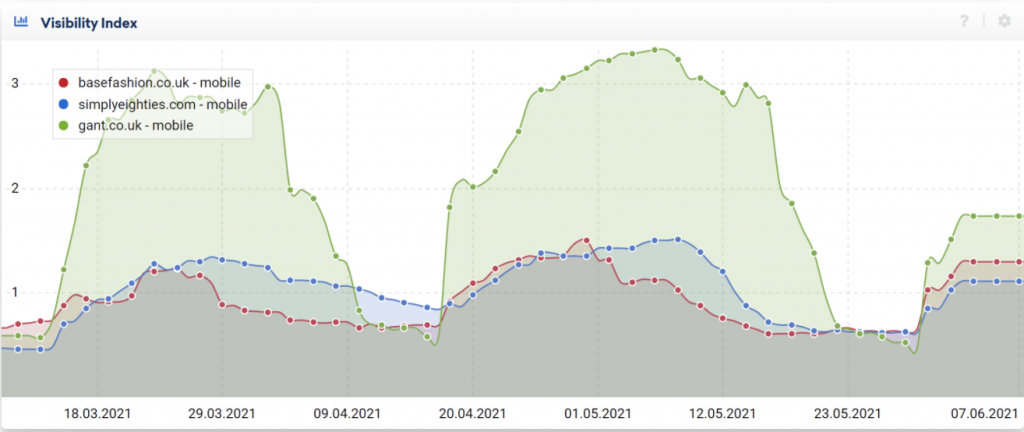
While temperatures start to rise with the start of the summer, the SEO community has started to feel the new “heatwave” coming from Google.
June kicked off as a fluctuate month with the new Google Core Update and continued with the Page Experience (initially scheduled to release in May). Following this, two spam updates hit the digital landscape by the end of the month. But that is not all.
While SEO professionals worldwide are still trying to understand the changes that the updates have caused to their sites, July is expected to be another powerful month.
To help you understand this and what is yet to happen, we have put together this roundup article. Stay tuned, and welcome to the summer of the updates!
1st June: John Mueller explains how to remove a sitemap on Search Console #AskGooglebot
Google continues educating both new and experienced users. In a new episode of Google Search Central, Webmaster John Mueller explained on #AskGooglebot what is a sitemap and how to remove it from Google Search Console.
2nd of June: Google Core Update began rolling out
As of the start of the month, the Google June 2021 Core Update began rolling out slowly on June 2nd, as the SEO industry did not felt much of its effect until several days after. Moreover, this Core Update will have a second part, scheduled for July.
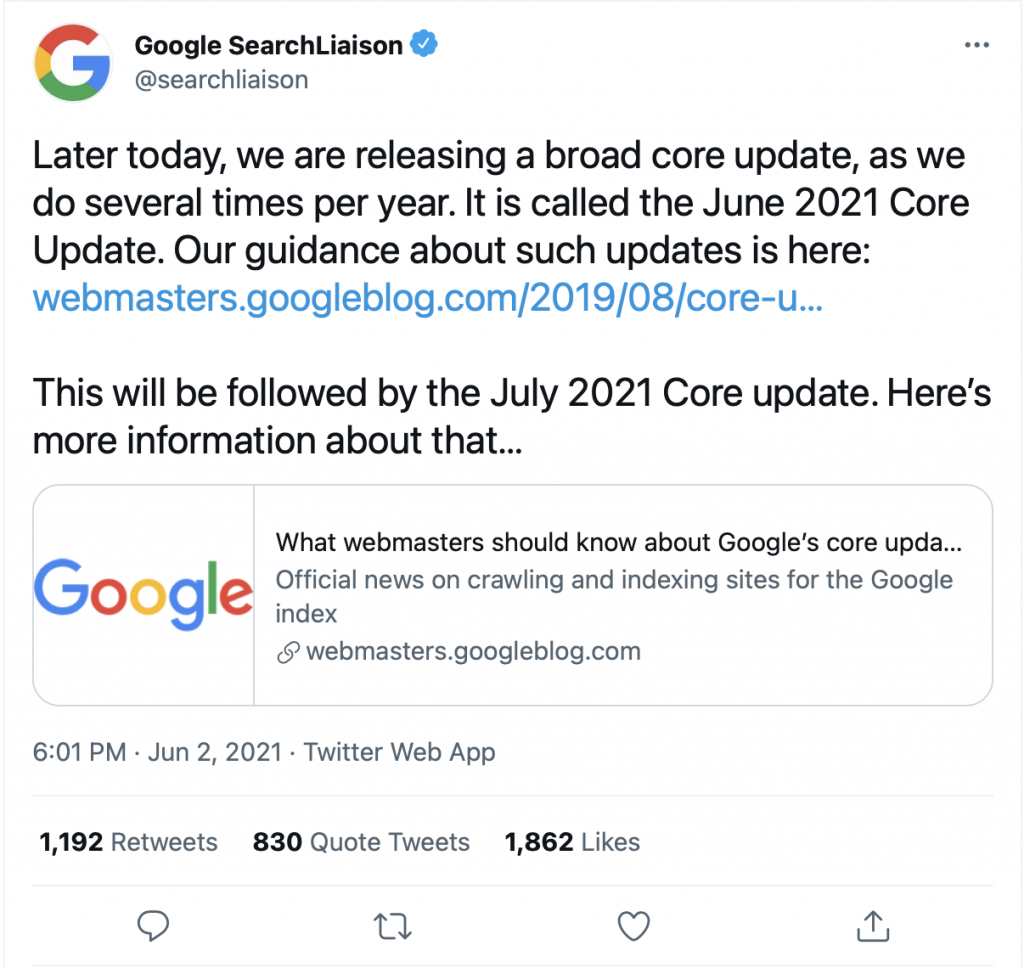
As Google Search Liaison published on Twitter, some of the changes weren’t ready in June, and therefore they will be “moving ahead with the parts that are, then we will follow with the rest with the July 2021 update.”
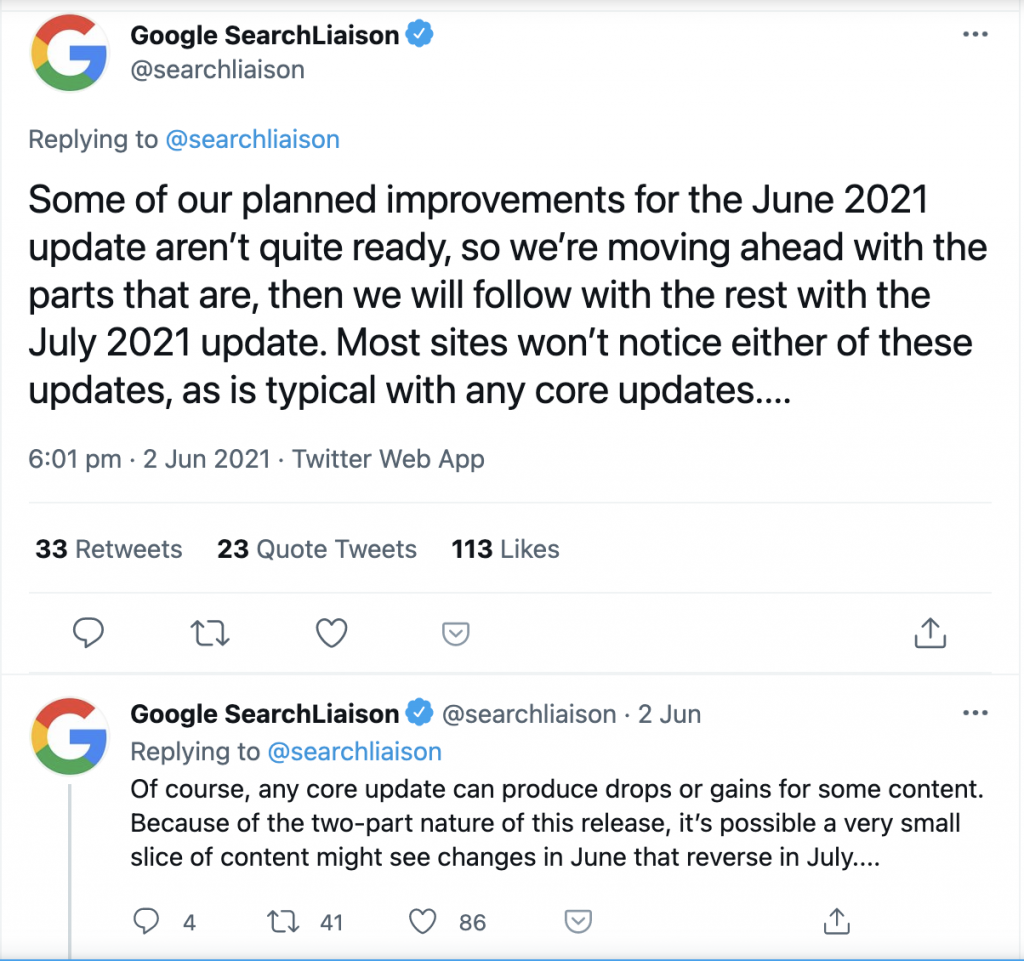
2nd June: Google Search Console regex filters update and quick tips
We were also thrilled out to find that, due to the feedback received on the latest Search Console Performance report regex filters, Google updated the Performance repost filter to support both matching and not matching regex filters. They also provided with new quick tips to users that are new to regex and regex filters.
9th June: The Search Central Unconference is back & WooCommerce merchants can list their products
Terry Ednacot and Martin Splitt announced that a new Virtual Unconference would take place on June 21st. The event, shaped in the form of discussions and feedback sessions, was an opportunity for users to get in touch with website owners, SEO professionals and Google product teams to help them deliver more value to the digital community.
Moreover, to make retailer’s life easier, WooCommerce merchants can upload their products to Google, produce listings and ad campaigns, and review their overall performance (all for free!). This is, retailers have now more visibility and shoppers have a wide variety of options when purchasing online.
12th June: Google June 2021 Core Update finished rolling out
The Google June 2021 Core Update finished rolling out as of 12th of June, which “showed a nice amount of Google fluctuation on June 11th and 12th “in words of Barry Schwartz, Search Engine Land’s editor. Up and downs was the general rule for all tracking tools, leaving the SEO community wanting to know more and just waiting to see the final resolution of the second part of this Core update in July.
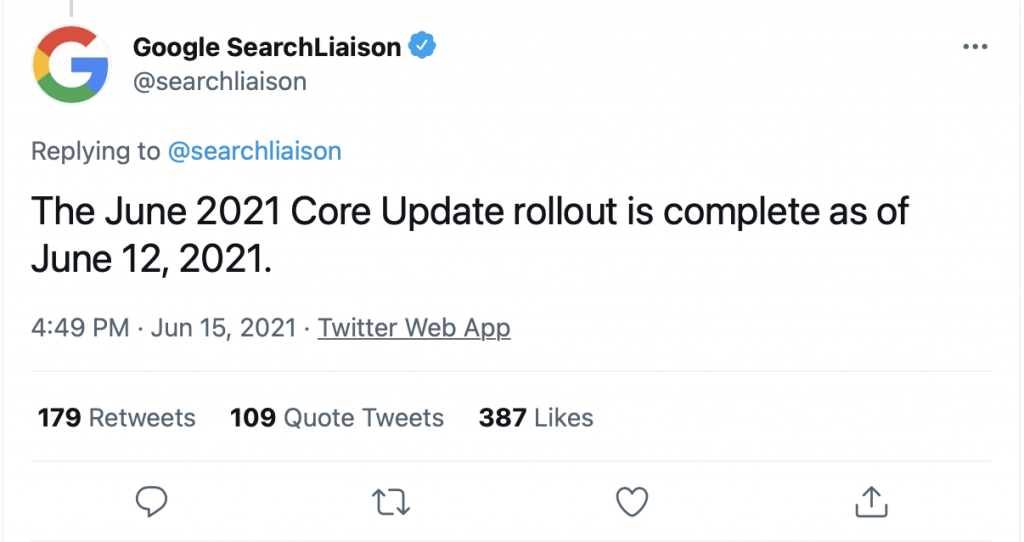
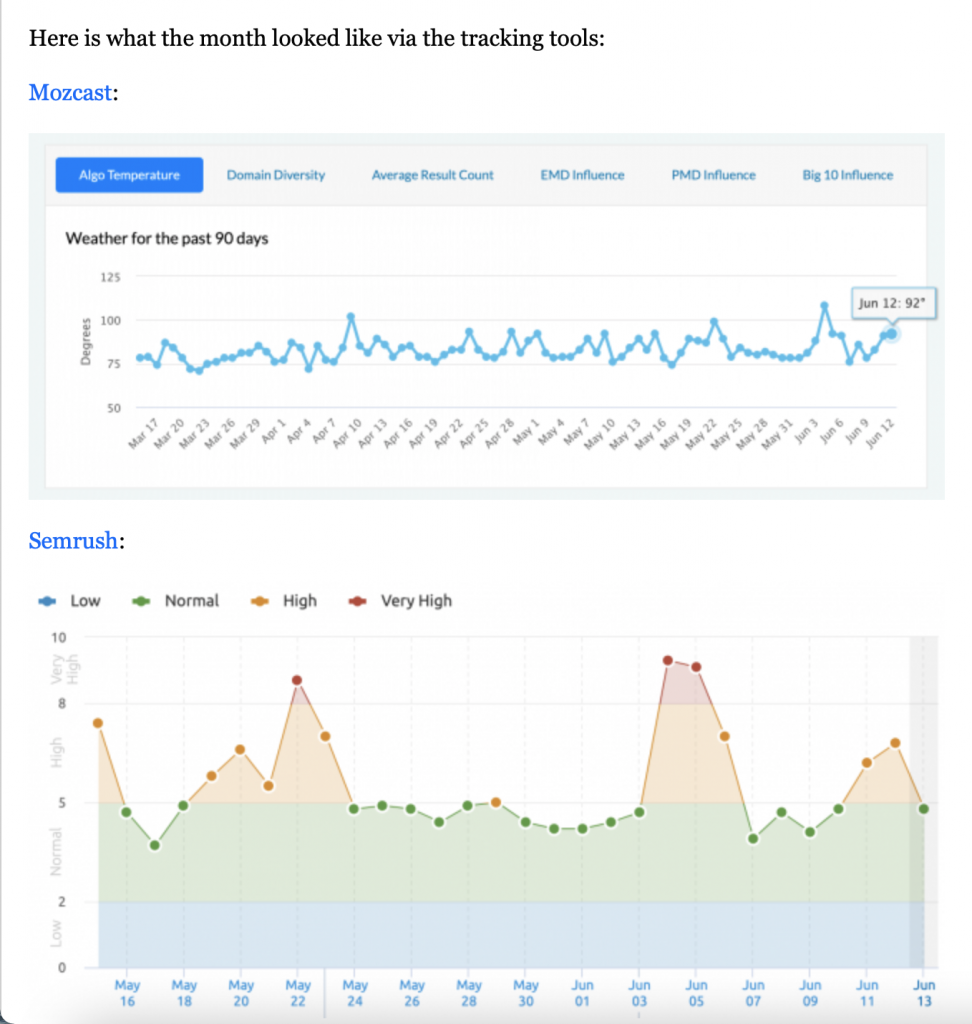
Image source: Barry Schwartz, Search Engine Roundtable
When comparing this new Core Update with old ones, RankRanger saw the June Update as being more substantial than the December 2020 update due to the increase in fluctuations in the top five results.
Yes, RankRanger felt that this update was much larger than the December 2020 update, which happened to be one of the largest core updates we’ve seen from Google yet. RankRanger said it was higher volatility “particularly in the top five positions.
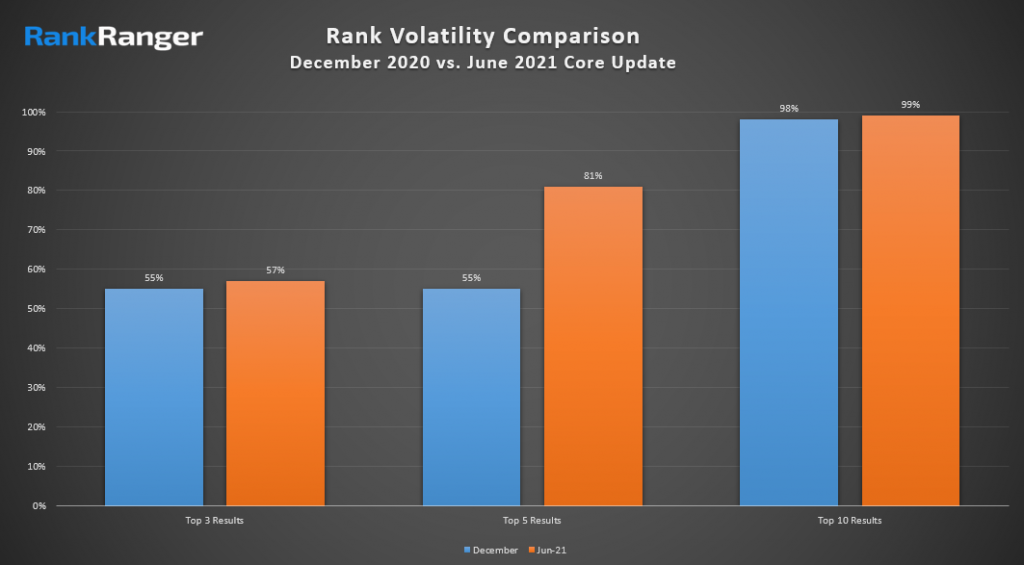
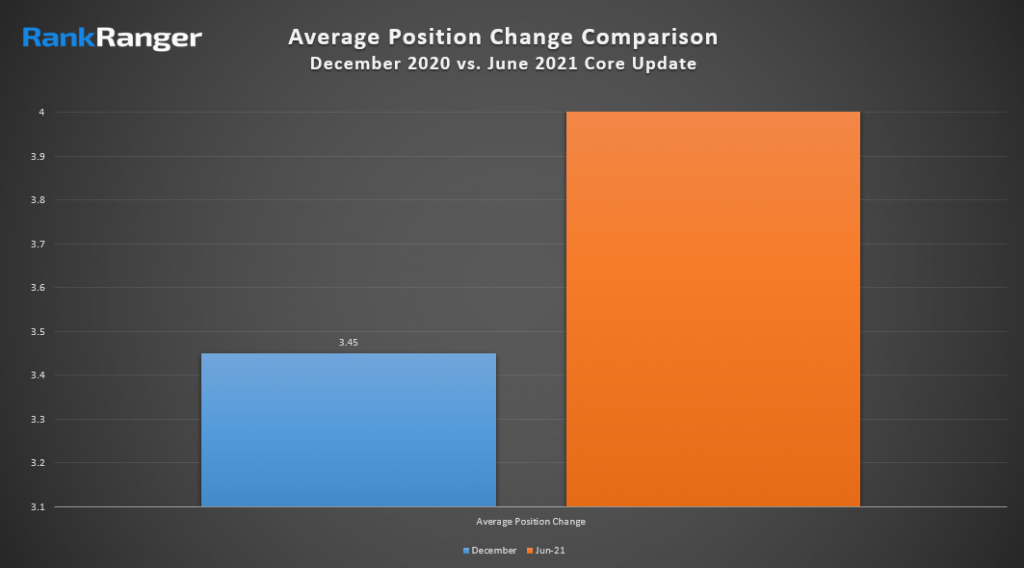
From the SEMrush’s team point of view, they said that this update was mostly felt on Friday the 4th and Saturday, June 5th. Following their analysis, the five top categories that experienced more changes were health, autos, pets, science and travel.
SEMrush also shared the winners (foursquare.com, alamy.com, manta.com, etc) and losers (okc-airport.com, quora.com, etc.) of this update.
SEMrush’s volatility by niche:
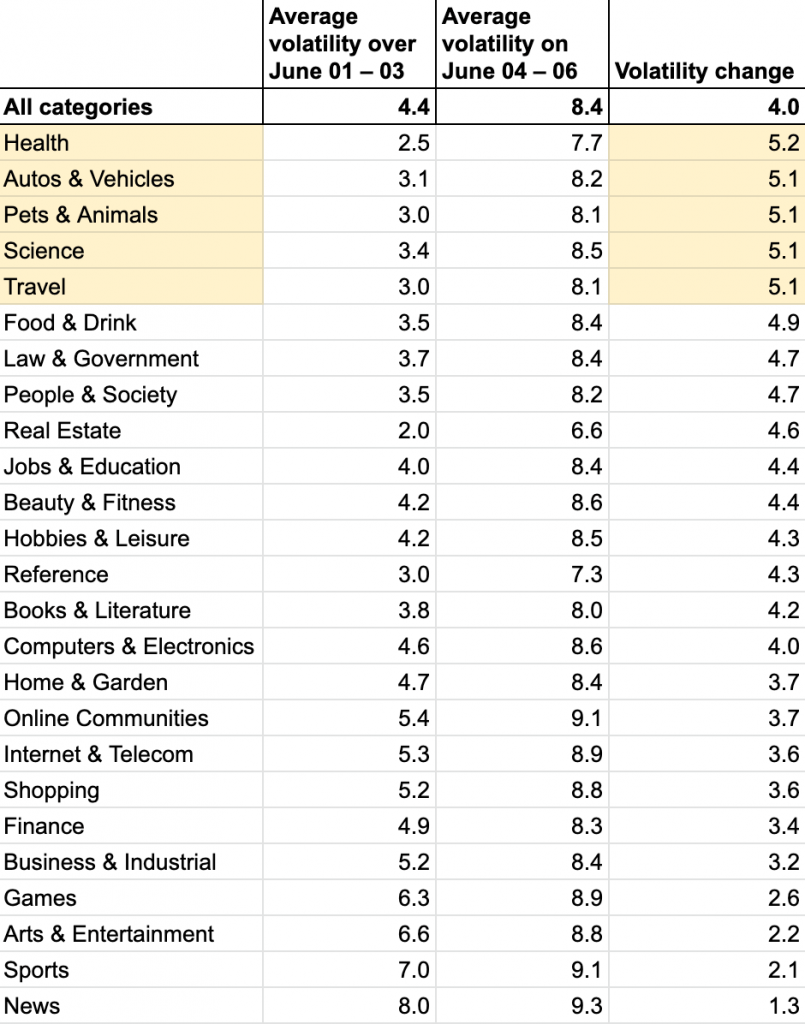
You can find more about the winners and losers of this update on Lily Ray’s analysis of the June 2021 Core Update.
From a different point of view, Sistrix identified some changes in visibility over three different domains that compete between them: basefashion.co.uk, simplyeighties.com, and gant.co.uk.
We appreciate that all three experienced similar changes, as they lost visibility but recover it right after.
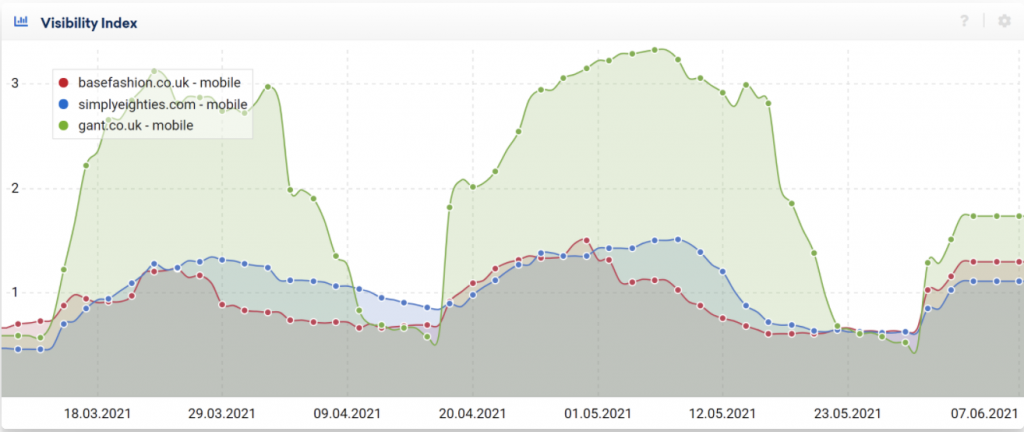
Source: Sistrix
A post from Lily Ray:
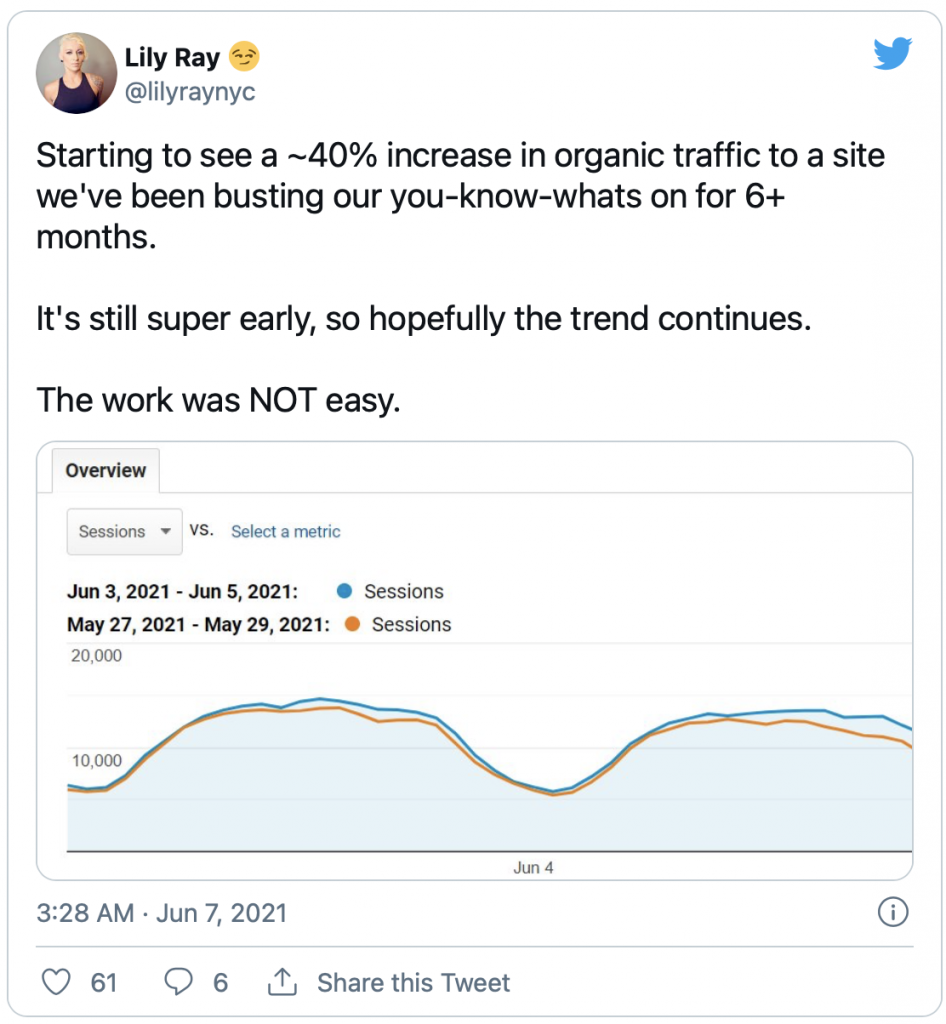
13th June: John Mueller answers ‘what to do about link building’
Google’s top advocate John Mueller gave us some tips about link building best practices in an Office Hours hangout. One of the questions that all SEOs have in mind was formulated: is it necessary to spend thousands of dollars for links? Mueller referred to how Google treats artificial links:
What should you do now…
I think that’s a super complicated question because there’s no one answer for everyone. So I think first of all, like you probably recognised, artificially building links, dropping links on other sites, buying links all of that is against the webmaster guidelines. And we take action on that algorithmically, we take action on that manually. And the actions that we take include demoting the site that is buying the links, demoting the site that is selling the links. Sometimes we also take more subtle action in that we just ignore all of those links.
On the other hand, when asked about paid links Mueller said:
For example, if we recognise that a site is regularly selling links but they also have other things around that, then we go in and say okay, we will ignore all links on this website. That basically means…a lot of these sites are things were people still sell links because it is like they can sell it and they find a seller then of course they will try to do that. But those links have absolutely no effect. So that seems like a big waste of time from my point of view.
15th June: The Google Page Experience Update began to roll out
The Google Page Experience Update finally started to roll out last month, as it was supposed to roll out in May but it was delayed until June.
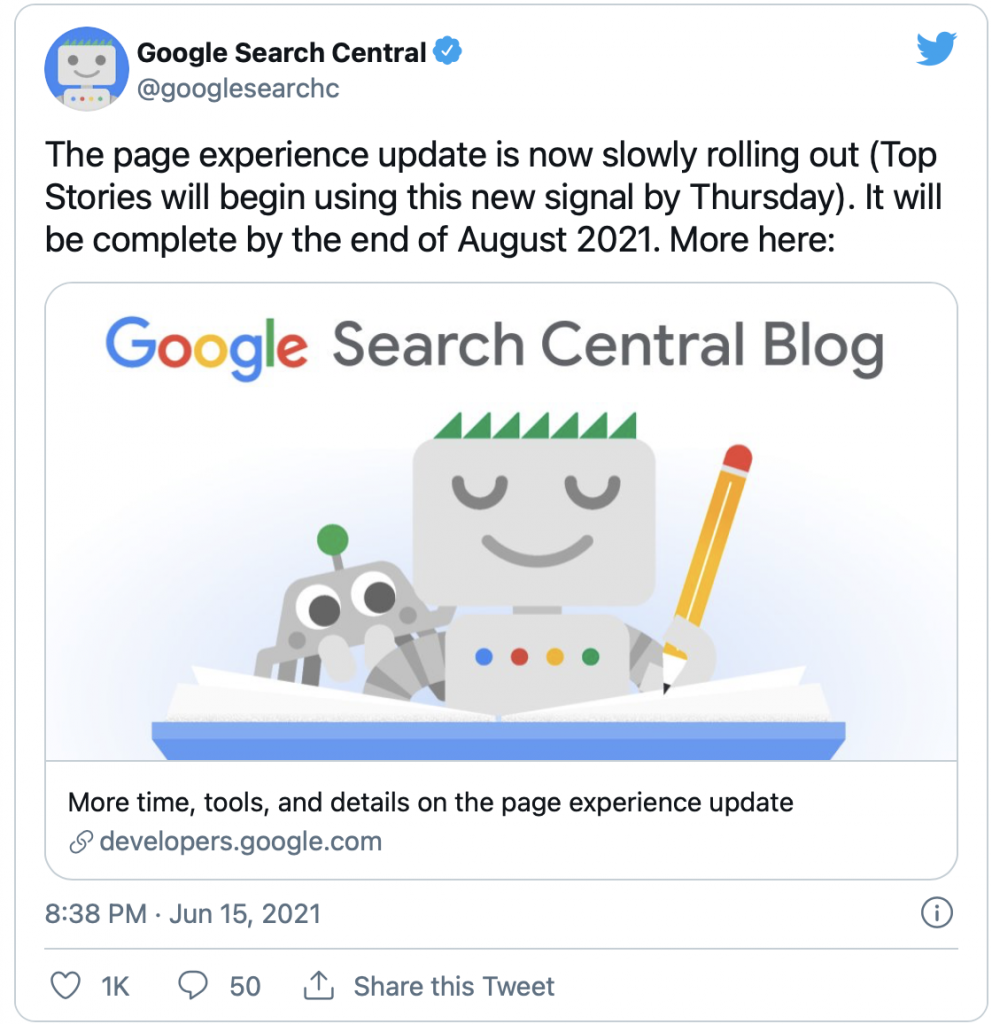
Moreover, the changes on the rankings caused by Google’s Page Experience Update began to roll out slowly and progressively, and it won’t be completed until the end of August. Therefore, sites are not expected to see big changes following this update,
As stated by Google:
We will begin using page experience as part of our ranking systems beginning in mid-June 2021. However, page experience won’t play its full role as part of those systems until the end of August. You can think it as if you are adding a flavouring to a food you’re preparing. Rather than add the flavour all at once into the mix, we’ll be slowly adding it all over this time period.
Then, why is this update so important? Let’s make a quick recap on Page Experience.
In plain words, Page Experience is an algorithm that measures the overall experiences of a user on a website and search results and then, the algo will sense if there’s something that needs improvement, to offer a better experience. Moreover, the most important page experience signals are mobile-friendliness, safe browsing (HTTPS/HTTP), and invasive interstitials.
Furthermore, Core Web Vitals are composed of various signals related to loading experience:
- Largest Contentful Paint. LCP measures the total time that it takes for the main content on a website to load. It focuses on what a user sees on the screen. A good LCP score will be 2.5 seconds, while from 4.0 it is considered to be too poor.

- First Input Delay. FID is in charge of measuring the impression of a page when the user first interacts with a page. Responsiveness and interactivity are the top factors here, and what it measures is the time it takes to a user from when it clicks the link to the time the browser responds to it.

- Cumulative Layout Shift. Finally, CLS analyses visual stability and measures non expected layout shifts. From 0.1 seconds being a good score, to 0.25 being identified as a poor score.

17th June: Changes coming to AMP and top stories
From now on, AMP won’t be necessary for inclusion in Top Stories. Moreover, this means that until now, only websites build with AMP HTML were considered for this section. Google will, from now on, previously ineligible content will be eligible. Therefore, if you want your site to appear in Top Stories, you will need to:
- Publish relevant content
- Keep a good score of Core Web Vitals and Page Experience
- Always follow Google’s guidelines.
Find all the details in the below video:
18th June: Google limits FAQ rich results to a maximum of two per snippet
Google has made some changes just to show two FAQ rich results maximum per search result snippet. A tweet from Mark Barrera showed us how those restricted FAQs look like after the update:
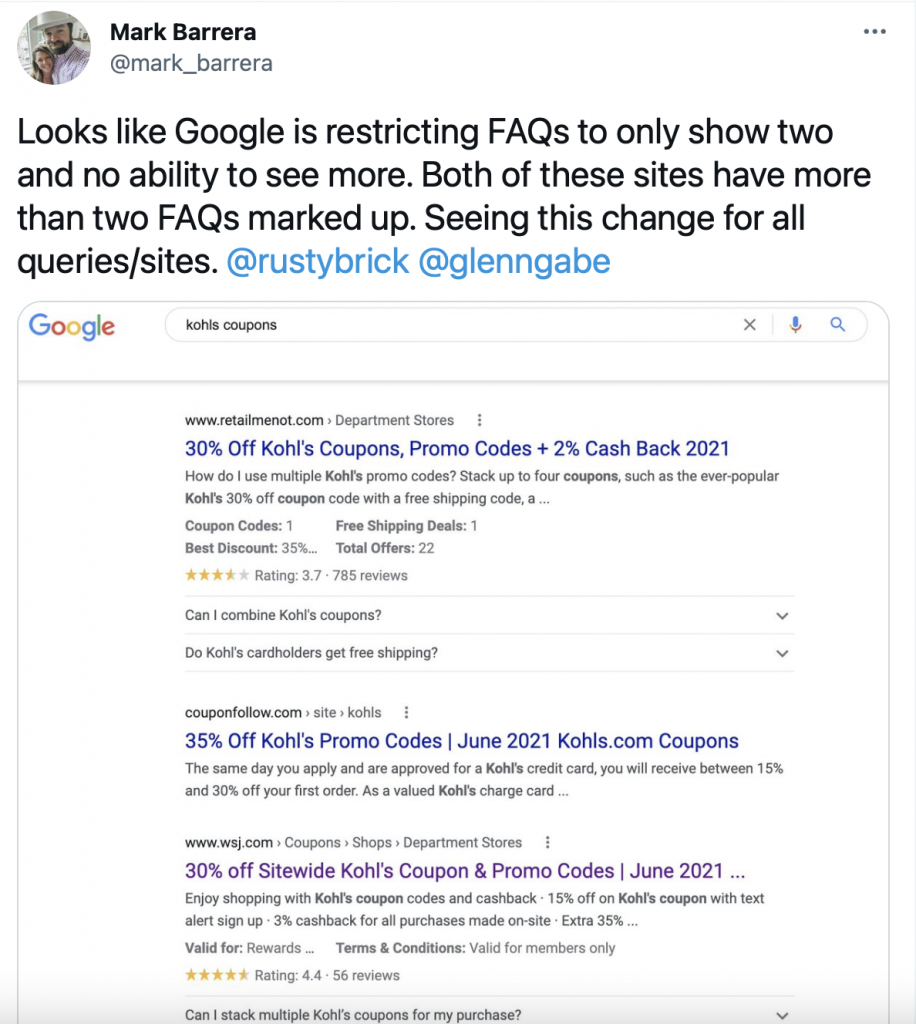
23rd June: Google Search releases an spam update & Insights from John Mueller
Google released a one-day spam update to improve search results:
“As part of our regular work to improve results, we have released a spam update to our systems”, the company said.
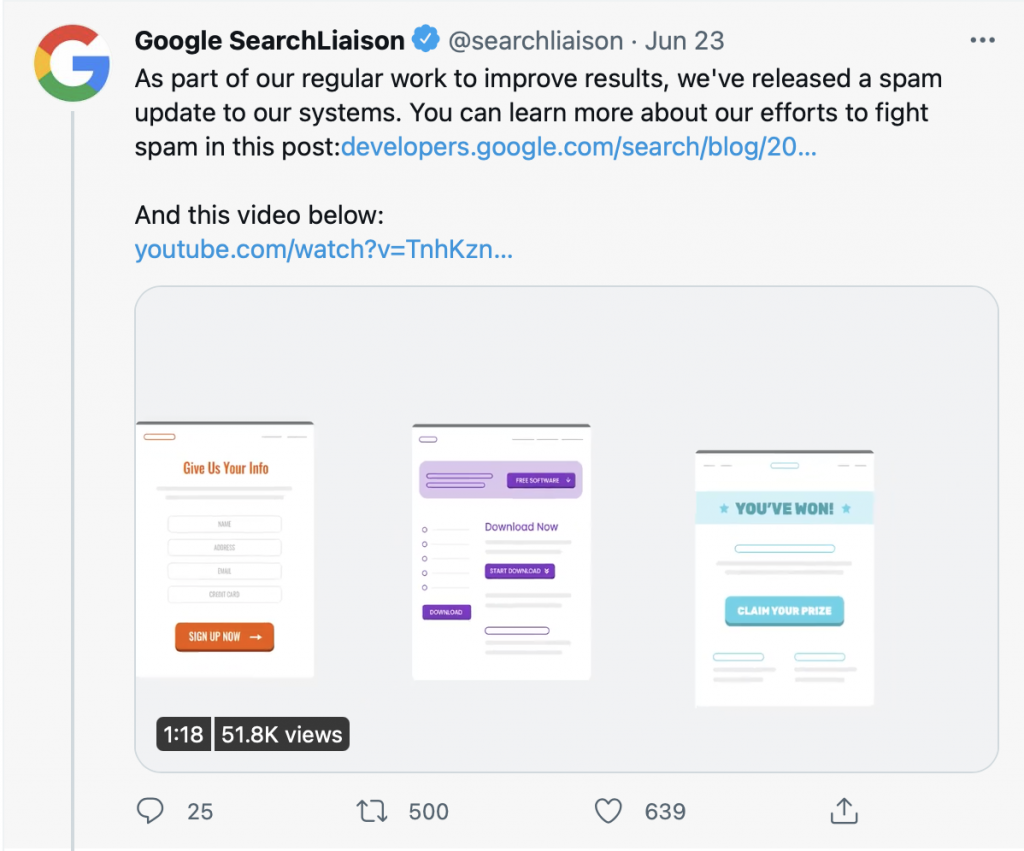
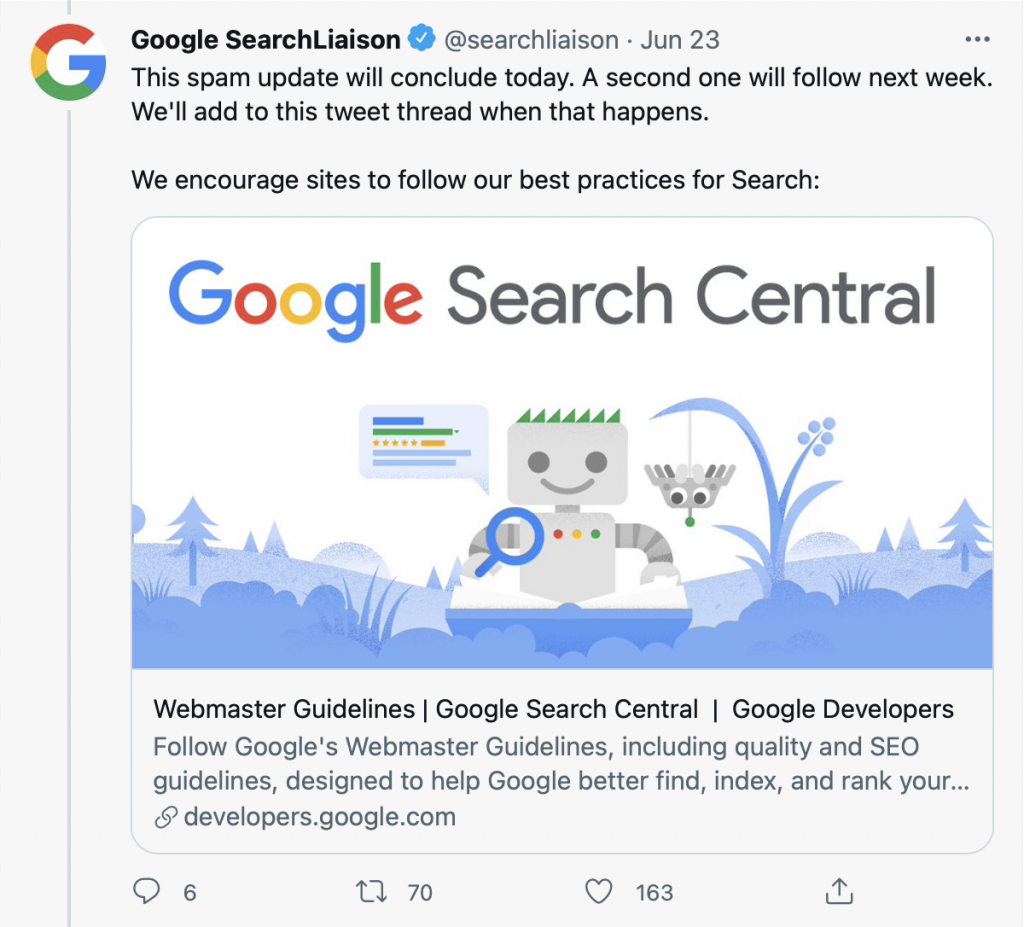
Google did not share much information apart from the official announcement on Twitter and a link to their Quality Guidelines.
Later that day, John Mueller shared some insights regarding recent developments in Google Search. In this new episode of Google Search News, Mueller talks about the June 2021 Google update, Page Experience and more.
24th June: Google News SEO: The definitive resources list
A new list of the official documentation, guides and tips was released by the one and only Barry Adams on SEO for Google News. This comprehensive list goes from official Google documentation (Google News policies, Technical guides, etc.) to third Part Guides (Search Engine Journal, DeepCrawl, etc.) and video content. If you are looking for a curated list with only curated information, this is the right place to go.
25th June: Google delays plans to block cookies until 2023 and pauses FLoC
Google announced last month that they will delay their plans to block third party cookies to late 2023 and will also pause testing of FLoC, its cookie less alternative.
We plan to conclude this origin trial in the coming weeks and incorporate input, before advancing to further ecosystem testing.
Google divided the process into two stages, the first one starting in late 2022, and stage 2 starting by mid-2023.
26th June: How HTTP status codes, network and DNS errors affect Google Search
Google has recently published a page describing how the different HTTP status codes, network errors and DNS errors affect Google Search. On it, they cover the top 20 status codes that Googlebot found on the web, the most notable network and DNS errors.
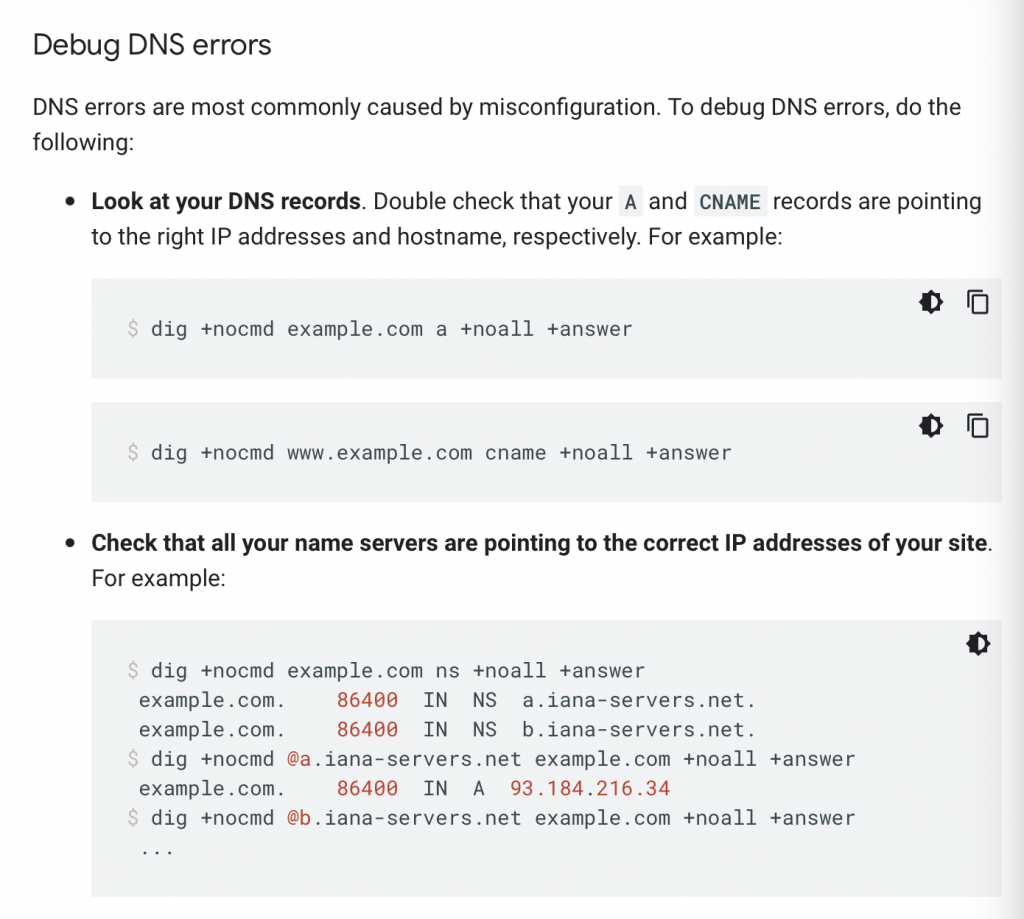
28th June: Part two of Google Search spam update is released
This second Google Search spam update was released by the end of the month, five days after the first one was released. Both parts were one-day updates and were “global” and targeted web and image results.
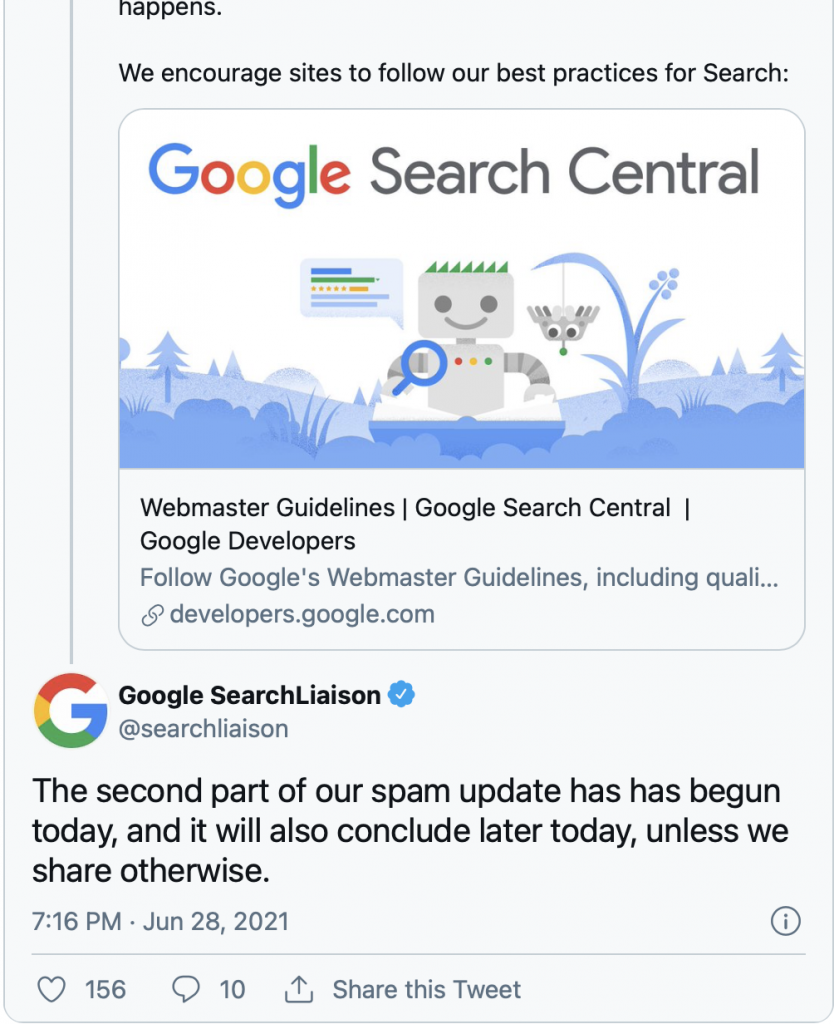
Moreover, the main target of this update was spam generated by hacked websites, and it was drove by Artificial Intelligence. In their own words:
By combining our deep knowledge of spam with AI, last year we were able to build our very own spam-fighting AI that is incredibly effective at catching both known and new spam trends.
For example, we have reduced sites with auto-generated and scraped content by more than 80% compared to a couple of years ago.
The kind of spam that Google does not look at with good eyes is, between others:
- Auto generated content
- Link schemes
- Unoriginal content
- Cloaking
- Hidden text or links
- Doorway pages
- Scraped content
- Abusing structured data
29th June: How MUM improved Google Searches for vaccine information
With a new technology called Multitask Unified Model (MUM), Google uses Artificial Intelligence to provide online users with a new experience when performing searches.
As coronavirus keeps occupying an important place within our lives, the internet giant has focused its efforts on offering the most accurate and trustworthy information about the COVID-19 vaccine. Furthermore, Google wanted to identify the different ways that people use to refer to vaccines all around the world. MUM is the tool that is behind this whole process. Thus, MUM has been able to identify over 800 variations of vaccine names in more than 50 languages in just seconds.
This way, MUM has helped users worldwide to get critical data promptly, opening the door for future systems and search improvements.
To wrap it up
June Core Update starts rolling out, the Spam update hits the ground two times, Core Web Vitals are a ranking factor from now on, etc. A lot has been going on in the SEO landscape during June. Keep an eye on your metrics, as July is going to be a very exciting month.


